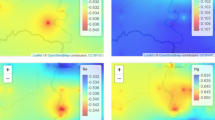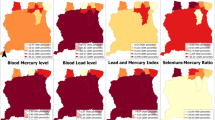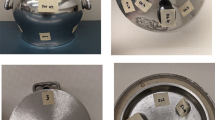Abstract
The high density of electroplating factories in the geographic middle of Taiwan has prompted concern over the potential for exposure to harmful metals. The present study aimed to determine the levels of chromium in whole blood (B-Cr) of residents living in the high vs. low factory-density areas, and to examine the relations to gender and age. A total of 660 residents who had not moved within the 5 years preceding the study were sampled according to the stratified random sampling approach, at ages 35–44, 45–54, and 55–64 years, for both genders. Chromium determinations (n=641) were made using a graphite furnace atomic absorption spectrometer. The geometric mean (95% C.I.) of B-Cr was 0.357 (0.34–0.38) μg/l. The International Federation of Clinical Chemistry (IFCC) nonparametric 0.95 reference limits of B-Cr was estimated to be <0.905 μg/l. B-Cr levels decreased with increasing age. Subjects in the areas with a high density (0.38 μg/l, 95% C.I.: 0.36–0.40) of electroplating factories had significantly higher B-Cr levels, compared to residents of the low-density (0.27, 0.25–0.30) areas and to the general population from western countries. The health significance of the elevated B-Cr remains to be determined.
This is a preview of subscription content, access via your institution
Access options
Subscribe to this journal
Receive 6 print issues and online access
$259.00 per year
only $43.17 per issue
Buy this article
- Purchase on Springer Link
- Instant access to full article PDF
Prices may be subject to local taxes which are calculated during checkout



Similar content being viewed by others
References
Aiyar J., Berkovits J., Floyd R.A., and Wetterhahn K.E. Reaction of chromium (VI) with glutathione or with hydrogen peroxide: identification of reactive intermediates and their role in chromium (VI)-induced DNA damage. Environ Health Perspect 1991: 92: 53–62.
Alessio L. Reference value for the study of low doses of metals. Int Arch Occup Environ Health 1993: 65: S23–S27.
Bárány E., Bergdahl I.A., Bratteby L.E., Lundh T., Samuelson G., Schutz A., Skerfving S., and Oskarsson A. Trace element levels in whole blood and serum from Swedish adolescents. Sci Total Environ 2002: 286: 129–141.
Baruthio F. Toxic effects of chromium and its compounds. Biol Trace Elem Res 1992: 32: 145–153.
Biedermann K.A., and Landolph J.R. Role of valence state and solubility of chromium compounds on induction of cytotoxicity, mutagenesis and anchorage independence in diploid human fibroblasts. Cancer Res 1990: 50: 7835–7842.
Chi X.Z. Microelement and Human Health. Chemical Industry Press, Beijing, 1997 p. 87.
Christensen J.M. Human exposure to toxic metals: factors influencing interpretation of biomonitoring results. Sci Total Environ 1995: 166: 89–135.
Christensen J.M., Holst E., Bonde J.P., and Knudsen L. Determination of chromium in blood and serum. Evaluation of quality control procedures and estimation of reference values in Danish subjects. Sci Total Environ 1993: 132: 11–25.
Cornelis R., Heinzow B., Herber R.F., Christensen J.M., Poulsen O.M., Sabbioni E., Templeton D.M., Thomassen Y., Vahter M., and Vesterberg O. Sample collection guidelines for trace elements in blood and urine. IUPAC Commission of Toxicology. J Trace Elem Med Biol 1996: 10: 103–127.
DFG (Deutsche Forschungsgemeinschaft). MAK- and BAT-Values. Report No. 28. DFG, VCH, Nurnberg, 1992.
Dixon W.J. Processing data for outliers. Biometrics 1953: 9: 74–89.
Harada A. Biological monitoring in medical surveillance in Japan. In: Fiserova-Bergerova V., Ogata M. (Eds.). Biological Monitoring of Exposure to Industrial Chemicals. ACGIH, Cincinnati, 1990, pp. 45–54.
HSE (Health and Safety Executive). Biological Monitoring for Chemical Exposures in the Workplace. UK HSE Guidance Note EH 56. London 1992.
Huang Y.L., Chen C.Y., Sheu J.Y., Chuang I.C., Pan J.H., and Lin T.H. Lipid peroxidation in workers exposed to hexavalent chromium. J Toxicol Environ Health 1999: 56: 235–247.
Huang Y.L., Chuang I.C., Pan C.H., Hsiech C., Shi T.S., and Lin T.H. Determination of chromium in whole blood and urine by graphite furnace AAS. Atom Spectrosc 2000: 21: 10–16.
IARC (International Agency for Research on Cancer). IARC Monograph on the Evaluation of Carcinogenic Risk to Humans: Chromium, Nickel and Welding. Vol. 49, IARC, Lyon, 1990, p. 677.
IDBMOEA (Industrial Development Bureau Ministry of Economic Affairs). Handbook of the Integrated Pollution Prevention Techniques for Metal Surface Treatment Industries — Electroplating Industry, Industrial Development Bureau Ministry of Economic Affairs, Executive Yuan, Republic of China, Taipei, 2002.
Kristiansen J., Christensen J.M., Iversen B.S., and Sabbioni E. Toxic trace element reference levels in blood and urine: influence of gender and lifestyle factors. Sci Total Environ 1997: 204: 147–160.
Kuo H.W., and Wu M.L. Effects of chromic acid exposure on immunological parameters among electroplating workers. Int Arch Occup Environ Health 2002: 75: 186–190.
Langardt S. One hundred years of chromium and cancer: a review of epidemiological evidence and selected case reports. Am J Ind Med 1990: 17: 189–215.
Lewis R. Metals. In: LaDou J. (Ed.). Occupational and Environmental Medicine. McGraw-Hill Companies, Inc., OH, USA, 1997, Chapter 27.
Lin Y.P., Teng T.P., and Chang T.K. Multivariate analysis of soil heavy metal pollution and landscape pattern in Changhua County in Taiwan. Landscape Urban Plan 2002: 62: 19–35.
Liou S.H., Wu T.N., Chiang H.C., Yang T., Yang G.Y., Wu Y.Q., Lai J.S., Ho S.T., Guo Y.L., Ko Y.C., Ko K.N., and Chang P.Y. Three–year survey of blood lead levels in 8828 Taiwanese adults. Int Arch Occup Environ Health 1996a: 68: 80–87.
Liou S.H., Wu T.N., Chiang H.C., Yang G.Y., Yang T., Wu Y.Q., Lai J.S., Ho S.T., Lee C.C., Ko Y.C., Ko K.N., and Chang P.Y. Blood lead levels in Taiwanese adults: distribution and influencing factors. Sci Total Environ 1996b: 180: 211–219.
Llobet J.M., Granero S., Torres A., Schuhmacher M., and Domingo J.L. Biological monitoring of environmental pollution and human exposure to metals in Tarragona, Spain. Trace Elem Electrol 1998: 15: 76–80.
Minoia C., Sabbioni E., Apostoli P., Pietra R., Pozzoli L., Gallorini M., Nocolaou G., Alessio L., and Capodaglio E. Trace element reference values in tissues from inhabitants of the European community I. A study of 46 elements in urine, blood and serum of Italian subjects. Sci Total Environ 1990: 95: 89–105.
Minoia C., Pietra R., Sabbioni E., Ronchi A., Gatti A., Cavallieri A., and Manzo L. Trace element reference values in tissues from inhabitants of the European community. III. The control of preanalytical factors in the biomonitoring of trace elements in biological fluids. Sci Total Environ 1992: 120: 63–79.
Paschal D.C., Ting B.G., Morrow J.C., Pirkle J.L., Jackson R.J., Sampson E.J., Miller D.T., and Caldwell K.L. Trace metals in urine of United States residents: reference range concentrations. Environ Res 1998: 76: 53–59.
Paustenbach D.J., Panko J.M., Fredrick M.M., Finley B.L., and Proctor D.M. Urinary chromium as a biological marker of environmental exposures: what are the limitations? Regul Toxicol Pharmacol 1997: 26: S23–S34.
Poulsen O.M., Christensen J.M., Sabbioni E., and Van der Venne M.T. Trace element reference values in tissues from inhabitants of the European Community: V. Review of trace elements in blood, serum and urine and critical evaluation of reference values for the Danish population. Sci Total Environ 1994: 141: 197–215.
Reed A.H., Henry R.J., and Mason W.B. Influence of statistical method used on the resulting estimate of normal range. Clin Chem 1971: 17: 275–284.
ROCEPA. Survey of heavy metals in the soil samples. In: Statistics Office of Environmental Protection Administration (Ed.). Yearbook of Environmental Statistics Taiwan Area, the Republic of China. Environmental Protection Administration of the Republic of China, Taipei, 1989.
ROCEPA. Survey of heavy metals in the soil samples. In: Statistic Office of Environmental Protection Administration (Ed.). Yearbook of Environmental Statistics Taiwan Area, the Republic of China. Environmental Protection Administration of the Republic of China, Taipei, 1992.
ROCEPA (Environmental Protection Administration of the Republic of China). Farmland Soil Heavy Metal Investigation and Contaminated Site Control Plan, Environmental Protection Administration of the Republic of China (Project No.: EPA-90-GA13-03-90A285) Taipei, 2002.
Rosenberg J., and Harrison R.J. Biological Monitoring. In: LaDou J. (Ed.). Occupational and Environmental Medicine. McGraw-Hill Companies, Inc., OH, USA, 1997, Chapter 38.
Seifert B., Becker K., Helm D., Krause C., Schulz C., and Seiwert M. The German environmental survey 1990/1992 (GerES II): reference concentrations of selected environmental pollutants in blood, urine, hair, house dust, drinking water and indoor air. J Expos Anal Environ Epidemiol 2000: 10: 552–565.
Snow E. Metal carcinogenesis: mechanistic implications. Pharamacol Ther 1992: 53: 31–65.
Solberg H.E. Approved recommendation on the theory of reference values Part 5: Statistical treatment of collected reference values: determination of reference limits. J Clin Chem Clin Biochem 1987: 25: 645–656.
Sorahan T., Burges D.C., Hamilton L., and Harrington J.M. Lung cancer mortality in nickel/chromium platers, 1946-95. Occup Environ Med 1998: 55: 236–242.
Standeven A.M., and Wetterhahn K.E. Possible role of glutathione in chromium (VI) metabolism and toxicity in rats. Pharmacol Toxicol 1991: 68: 469–476.
Versieck J., Barbier F., Cornelis R., and Holst J. Sample contamination as a source of error in trace element analysis of biological samples. Talanta 1982: 29: 973–984.
Versieck J., and Cornelis R. Trace Elements in Human Plasma or Serum, CRC Press, Orlando, FL, USA, 1989.
Vesterberg O., Alessio L., and Brune D. International project for producing reference values for concentrations of trace elements in human blood and urine — TRACY. Scand J Work Environ Health 1993: 19: 19–26.
Wang C.L., Chuang H.Y., Ho C.K., Yang C.Y., Tsai J.L., Wu T.S., and Wu T.N. Relationship between blood lead concentrations and learning achievement among primary school children in Taiwan. Environ Res 2002: 89: 12–18.
Wetterhahn K.E., and Hamilton J.W. Molecular basis of hexavalent chromium carcinogenicity effect on gene expression. Sci Total Environ 1989: 86: 113–129.
White M.A., and Sabbioni E. Trace element reference values in tissues from inhabitants of the European Union. X. A study of 13 elements in blood and urine of a United Kingdom population. Sci Total Environ 1998: 216: 253–270.
Yang T., Wu T.N., Hsu S.W., Lai C.H., Ko K.N., and Liou S.H. Blood lead levels of primary-school children in Penghu County, Taiwan: distribution and influencing factors. Int Arch Occup Environ Health 2002: 75: 528–534.
Zhitkovich A. Chromium: exposure, toxicity, and biomonitoring approaches. In: Wilson S.H., Suk W.A. (Eds.). Biomarkers of Environmentally Associated Disease: Technologies, Concepts, and Perspectives. Lewis Publishers, Boca Raton, 2002, Chapter 19.
Acknowledgements
The financial support (No. DOH91-TD-B04) of Department of Health of the Republic of China is gratefully acknowledged. We thank the Changhua population for support and participation in this study. We thank Dr. S. H. Liou and Dennis P. H. Hsieh of the Division of Environmental Health and Occupational Medicine, National Health Research Institutes (Taiwan), for their valuable suggestions. We are highly indebted to the Changhua Christian Hospital, the Changhua Public Health Bureau and the public health nurses, and the Changhua Environmental Protection Bureau for their support. We thank Y.C. Wang, C.Y. Peng, C.J. Li and H.Y. Yu for their valuable assistance in collecting the samples, and to H.J. Wang for her technical assistance in analytical work.
Author information
Authors and Affiliations
Corresponding author
Additional information
Disclaimer
The scientific content of this manuscript has been reviewed and approved for publication by the Division of Environmental Health and Occupational Medicine of the National Health Research Institutes. Approval for publication does not necessarily signify that the content reflects the view and policies of the DEHOM/NHRI, or condemnation or endorsement and recommendation for use on this issue presented.
Appendix A
Appendix A
-
1
According to our sample collection protocol, collect whole blood from 5 to 10 nonexposed healthy persons and mix the bloods collected.
-
2
Take seven aliquots from the above whole blood mixture. Add chromium stock solution into each aliquot to prepare seven samples at the same concentration near one-fifth of the lowest-concentration calibration standard.
-
3
Pretreat the seven samples and analyze them according to the standard operation procedure, which is the same as used for subject’s specimens.
-
4
Calculate the standard deviation (Sα) of the seven readings.
-
5
Take another seven aliquots from the above whole blood mixture. Add chromium stock solution into each aliquot to prepare seven samples at the same concentration of half of the last additive concentration. Repeat Steps 3 and 4 and calculate another SD (Sβ).
-
6
Use F-test to evaluate the two SDs (let S1 and S2 be the larger and smaller ones between Sα and Sβ). If

is less than 3.05, then use the following equation to calculate the pooled standard deviation, Spooled.

-
7
If in Step 6 F is not less than 3.05, then repeat Steps 5 and 6 until F is less than 3.05.
-
8
Method detection limit (MDL) = 2.681 Spooled/a. „a” is the slope of the calibration curve.
Rights and permissions
About this article
Cite this article
Chang, FH., Wang, SL., Huang, YL. et al. Biomonitoring of chromium for residents of areas with a high density of electroplating factories. J Expo Sci Environ Epidemiol 16, 138–146 (2006). https://doi.org/10.1038/sj.jea.7500445
Received:
Accepted:
Published:
Issue Date:
DOI: https://doi.org/10.1038/sj.jea.7500445
Keywords
This article is cited by
-
Individual, sociodemographic, and lifestyle influence on blood chromium, cobalt, and nickel levels in healthy population living in Belgrade, Serbia
Environmental Science and Pollution Research (2023)
-
Elevated cadmium and 8-hydroxy-2’-deoxyguanosine (8-OHdG) levels in residents living near electroplating industries
Environmental Science and Pollution Research (2021)
-
The relative impact of toxic heavy metals (THMs) (arsenic (As), cadmium (Cd), chromium (Cr)(VI), mercury (Hg), and lead (Pb)) on the total environment: an overview
Environmental Monitoring and Assessment (2019)
-
Levels and temporal variations of urinary lead, cadmium, cobalt, and copper exposure in the general population of Taiwan
Environmental Science and Pollution Research (2019)
-
Biomonitoring of cadmium, chromium, nickel and arsenic in general population living near mining and active industrial areas in Southern Tunisia
Environmental Monitoring and Assessment (2014)





